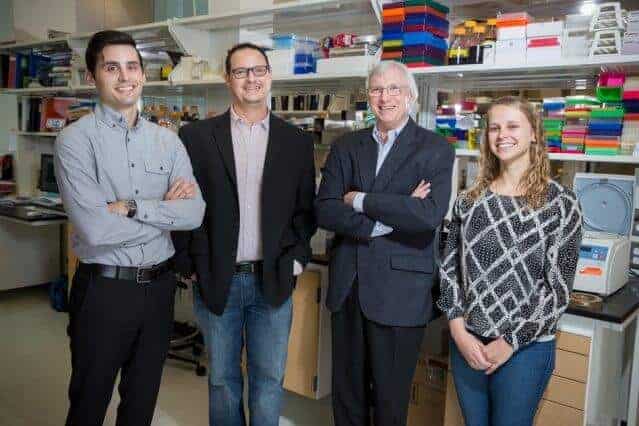New cancer drugs allow doctors to tailor treatment based on the genetic profile of a patient’s tumor. However, these drugs don’t work at all in some patients, and they lose their effectiveness in others.
A new study from MIT and Massachusetts General Hospital reveals why a certain class of these drugs, known as kinase inhibitors, doesn’t always halt tumor growth. The researchers found that while kinase inhibitors successfully shut down their targets, they also provoke cells to turn on a backup system that can take over for the one knocked out by the drug.
The team also showed that disrupting both systems with a combination of drugs yields much better results, in a study of mice.
“We’ve discovered a previously unappreciated mechanism involved in resistance to targeted therapeutics,” says Douglas Lauffenburger, the Ford Professor of Bioengineering and head of MIT’s Department of Biological Engineering. “Its presence appears to be associated with poor response to some kinase inhibitors in clinical patients. And we’ve demonstrated that in mice adding a drug against this resistance mechanism allows the original targeted drug to work when otherwise it wouldn’t.”
Lauffenburger, who is also an affiliate member of MIT’s Koch Institute for Integrative Cancer Research, is the senior author of the study, which appears in the March 16 online edition ofCancer Discovery. The lead authors are Miles Miller, a former MIT graduate student who is now a postdoc at Harvard Medical School, and Madeleine Oudin, a Koch Institute postdoc.
Bypass system
Kinase inhibitors, frequently used against breast, ovarian, and other cancers, work by disrupting cell signaling pathways that stimulate cells to grow, proliferate, or become invasive. Doctors usually prescribe them based on whether a patient’s tumor is overexpressing a cancer-driving protein such as epithelial growth factor receptor (EGFR).
However, these drugs can fail even in tumors where they should work. About half of these failures are caused by genetic mutations that allow cancer cells to evade the drug’s actions, but the rest are unexplained, Lauffenburger says.
Based on their previous studies of endometriosis (when uterine tissue grows into surrounding organs), Lauffenburger and his colleagues suspected there could be a backup pathway helping cancer cells to sidestep the effects of kinase inhibitors. In those studies, the researchers found that invasive endometrial cells become “addicted” to a certain growth signal, and that this pathway actually shuts off other growth pathways. Drugs that shut down the primary pathway can have the unintended effect of activating those backup systems.
The MIT team wondered if the same thing might be happening in cancer cells. They focused on melanoma and triple-negative breast cancer, two very aggressive forms of cancer that are often driven by EGFR ligands (molecules that activate the receptor), which help the cancer cells to become motile and invasive.
They found that when EGFR ligands bind to receptors on the cancer cell surface, they not only trigger a cascade of cellular reactions that promotes invasiveness but also activate a positive feedback loop: Enzymes called proteases release EGFR ligands from the cell surface so they can bind to even more receptors, strengthening the pro-invasion signal.
The researchers found that those proteases also chop off receptors that initiate other pro-invasion pathways. Essentially, the cancer cells become addicted to the EGFR-driven pathway and shut off competing pathways because they don’t need them, Lauffenburger says.
“The cells have the capability for other inputs, but if they’re already signaling through one, they’re perfectly happy to shut down the rest,” he says.
Consequently, when doctors give a kinase inhibitor that shuts off the EGFR pathway, it also shuts off the proteases, allowing the backup pathways, which are no longer being suppressed, to take over.
More accurate predictions
The researchers also showed that these cleaved receptor proteins can be detected in blood samples from patients, and that the protein levels correlate with how well EGFR inhibitors work for individual patients.
High levels of cleaved proteins mean that there is a lot of potential for the backup system to kick in, and kinase inhibitors will not be effective. However, if these protein levels are low, that suggests the backup system is not very strong in that patient’s tumor.
“The discovery seems to identify those patients who will go on to receive long-term clinical benefit versus those whose tumors will quickly adapt and circumvent treatment, by virtue of a blood-based test that can be performed at baseline or within days of initiating treatment,” says Keith Flaherty, an author of the paper and director of developmental therapeutics at the MGH Cancer Center, who hopes to begin performing this kind of test in patients.
The study also suggests that patients whose tumors have a strong backup system could benefit from receiving an EGFR inhibitor plus a drug that shuts down the secondary pathway. One candidate is a type of drug known as an AXL inhibitor, which is now in clinical trials. In mouse studies, the MIT team found that treating tumors with that combination of drugs was much more effective than giving either one alone.
“Not only can the activation of this novel drug resistance mechanism be identified in patients by measuring (blood) serum receptor levels, but it is therapeutically tractable by combined targeting of cell surface receptors and intracellular signaling molecules. This important study provides novel mechanisms, new biomarkers, and the potential for rapid implementation to improving patient outcomes,” says Gordon Mills, a professor of medicine and immunology at the University of Texas MD Anderson Cancer Center, who was not involved in the research.
Other MIT authors include Frank Gertler, a professor of biology and member of the Koch Institute, Linda Griffith, a professor of biological engineering and mechanical engineering and affiliate member of the Koch Institute, graduate student Stephanie Wang, research scientist Aaron Meyer, and technical associate Jenny Tadros.


